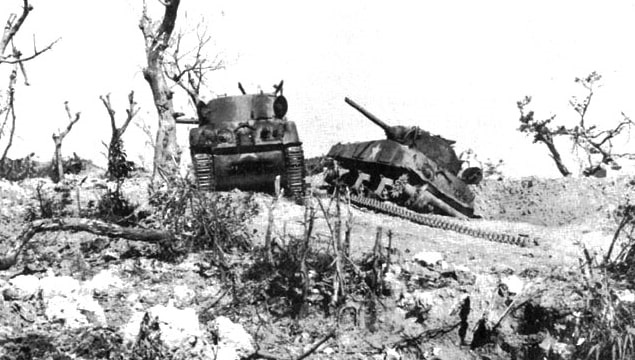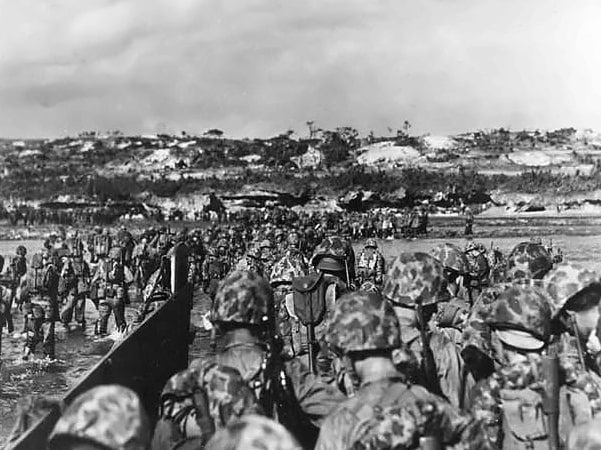In the spring of 1945, the Japanese empire was crumbling and Allied commanders were thinking about the upcoming invasion of the Japanese homeland. One key objective was left, however: Okinawa, largest of the Ryukyu Islands, only 340 miles from the homeland. It was heavily defended by more than 100,000 determined and well-fortified Japanese troops, but it was a prize the Allies had to have: control of Okinawa would provide airfields close to Japan, anchorage for Allied warships, and staging areas for the massive number of troops needed for the invasion of Japan.
On 1 April 1945, the Battle of Okinawa began – it was both Easter Sunday and April Fool’s Day. It would last 82 long, bloody days.

The landing force was made up of 183,000 U.S. marines and soldiers, supported by more than 1,400 warships (including 17 British ships) and hundreds of airplanes. Although Japanese resistance was light on the first day, as described in the following newspaper articles, the fighting soon grew fierce – and the Americans quickly realized they were in for a long, tough fight.
The combat was difficult and deadly, the Japanese defenders hunkered down in fortified caves and refusing to budge. By the time the battle ended on June 22, around 100,000 Japanese soldiers had been killed, while only about 8,000 surrendered – these mainly Okinawans, who had been pressed into combat duty by the Japanese. The Allies suffered more than 60,000 casualties.

Perhaps the most tragic part of the loss of human life during the Battle of Okinawa was the Okinawans. Mostly uneducated peasants and fishermen, the local populace had been cowed by the Japanese military, and terrified by stories that the invading Americans would rape, torture and kill all civilians, including children. Japanese soldiers distributed grenades to the civilians and ordered them to commit suicide.
Thousands of Okinawans did, some using the grenades, others resorting to hanging. In some instances, mothers and fathers first killed their children, then themselves. The number of victims will never be known, but between the suicides and being caught in the middle of 82 days of explosive fighting, anywhere from 40,000 to 150,000 Okinawans are estimated to have died.
Here is a transcription of this article:
Enemy Resistance Light on Okinawa
Yanks Gain Three Miles on Nip Isle
Two Airfields, More than a Dozen Towns and Villages Taken
(By The Associated Press)
One of the most vital blows of the Pacific war was struck Easter Sunday morning (Japanese time) by America’s new 10th army when Yank doughboys and marines invaded Okinawa, main island of the Ryukyus just 325 miles southwest of the Nippon homeland.
The Japanese offered amazingly light opposition among the 9,000-yard west coast beachheads and the American forces quickly seized two airfields and more than a dozen towns and villages in the area some 10 miles north of the naval base city of Nara, capital of Okinawa. Initial Yank casualties were exceptionally light, but American commanders felt there was a tough fight ahead.
In a second Sunday communiqué, Fleet Admiral Chester W. Nimitz announced the Yanks advanced rapidly throughout the day and by 6 p.m. (Tokyo time) forward elements of both the infantry and marines had expanded their beachheads to a depth of three miles at several points.
Enemy resistance continued light. Landing beaches were secured against small arms fire and landing of supplies was started immediately.
Heavy warships and carrier planes continued their bombardment of Okinawa’s defenses. Four attacking Japanese planes were destroyed.
Three hundred miles to the south, carrier planes from the British task force heavily attacked the Sakishima islands. They destroyed 14 and damaged 6 of 20 enemy planes which landed on the islands during the raid.
New Air Bases
The Ryukyus, standing guard at the entrance to the East China Sea, will give America new air bases for mounting raids on the Japanese homeland, aerial strikes against Formosa, and a doorway to China’s coast. Fleet Admiral Chester W. Nimitz declared: “As our sea and air blockade cuts the enemy off from the world and as our bombing increases in strength and proficiency, our final decisive victory is assured.”
Meanwhile a large force of American Superfortresses, striking from the Marianas, resumed the attack on Tokyo district military targets. The strike came on the heels of the Okinawa landings.
The Okinawa invasion armada of more than 1,400 ships put ashore elements of a Yank army that may total 100,000 fighting men. They face about 80,000 Japanese defenders on the 65-mile-long island.
It was apparent that pre-invasion naval gun and aerial bombardments of 10 days’ duration drove Japanese soldiers to the hills. The Nipponese offered little opposition on land and none at sea or in the air as assault waves hit the beaches. An hour later they dropped light mortar and artillery fire on the beachheads and engaged in a brief tank action on the northern flank.
Reporting from Okinawa, Associated Press War Correspondent Robbin Coons said waves of troops and supplies continued to pour ashore Sunday afternoon while American planes were blasting and strafing along the front lines.
In the softening up of the Ryukyus prior to the landings American and British men-of-war poured an almost steady stream of shot steel ashore while swarms of carrier planes blasted the islands. On March 26 an infantry division invaded the Kerama group, just off Okinawa’s southwest tip. In those islands some 200 Japanese civilian men, women and children committed mass suicide in the face of the invasion.
In the Keramas the Americans seized scores of explosive-laden suicide boats, intended for use against the invasion fleet.
Radio Tokyo said “heavy fighting” was in progress at Okinawa; it made the unconfirmed claim that Japanese fliers sank 16 ships including 8 warcraft.
Here is a transcription of this article:
Rising Sun Shines Only for Americans in Okinawa Invasion
By Robbin Coons
With the Assault Forces, Okinawa, April 1 – (AP) – Streaming ashore directly into the face of a rising sun which sparkled on an ideally smooth sea, thousands of American troops quickly established beachheads on this island “front porch” of Japan’s homeland today.
They drove in rapidly against scant initial opposition.
The rising sun symbol of the Japanese empire seemed to shine this Easter Sunday only for invading Americans who rolled several hundred yards across the empire’s “sacred” soil.
A terrific covering naval bombardment greeted the rosy Easter dawn as a climax of days of furious attack. It tore holes in target areas of the sea wall, permitting entry of tanks and other armored vehicles.
Landings were preceded also by a concerted strike of a great force of carrier-based aircraft.
This unit of the convoy, like the others, was unmolested through hundreds of miles of open sea. It was prepared for a concerted enemy carrier assault which so far has failed to materialize.
Fleet and ground forces nevertheless are alert against the possibility of the enemy attempting a deceptive All Fool’s Day trick.
Note: An online collection of newspapers, such as GenealogyBank’s Historical Newspaper Archives, is not only a great way to learn about the lives of your ancestors – the old newspaper articles also help you understand American history and the times your ancestors lived in, and the news they talked about and read in their local papers. Did any of your family members serve in WWII? Please share your stories with us in the comments section.
Related Articles:
